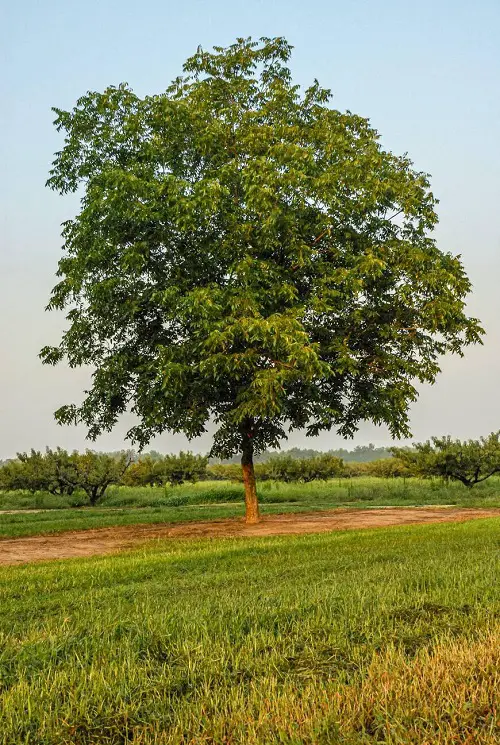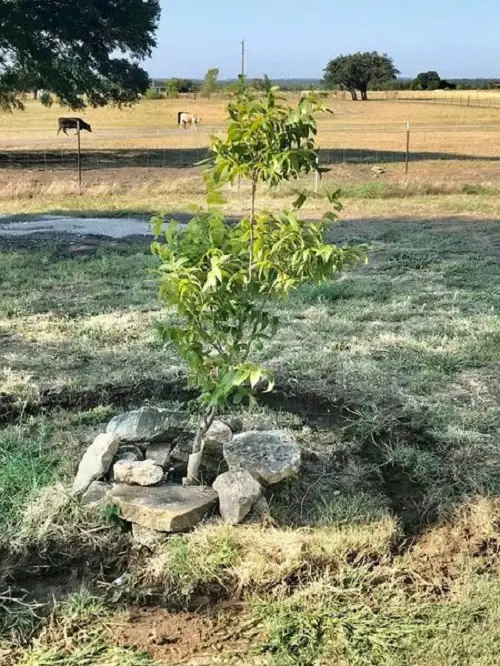We’ve got everything covered for you in our Growing Pecan Trees guide. Don’t miss out on these massive trees and their fruits!
Growing pecan trees can be rewarding but requires patience and careful planning. These majestic trees have delicious nuts and provide plenty of shade but demand ample space, fertile soil, and regular care. With the right conditions, dedication, and a bit of our guidance, you can enjoy the fruits of your labor for generations to come.
Pecan Tree Information

Pecan trees are stately giants belonging to the walnut family, native to the temperate regions of North America. These trees are famous for their delicious nuts but offer so much more. With their towering heights, often reaching 100 feet or more, and broad, spreading canopies, they provide ample shade during hot summers.
Pecan trees produce compound leaves with multiple leaflets arranged in a feather-like pattern. They also have tiny, inconspicuous flowers that give way to the beloved nuts, encased in a tough husk that splits open to reveal the prized kernel within.
While growing a pecan tree demands patience, as it takes several years to bear fruit, the rewards are undoubtedly sweet. They help improve soil quality, provide habitat for wildlife, and contribute to a healthier environment. Pecan oil, extracted from the nuts, is prized for its culinary and cosmetic uses.
Botanical Name: Carya illinoinensis
USDA Zones: 5-9
Propagating and Growing Pecan Trees

It’s possible to grow pecan trees from seed, but we won’t recommend it for home gardeners. This is because trees grown from seed don’t always produce the same quality or quantity of nuts as their parent tree. Instead, most people opt for grafted trees; it’s also the smarter choice because it’ll be quicker.
Buying a grafted tree from a reputable nursery is the easiest way to get started. A grafted pecan tree is essentially a superior variety (the scion) joined to a hardy rootstock. It will give you the best of both worlds–the delicious nuts of the desired variety and the strong root system of the rootstock.
Once you have your tree, plant it in a location with full sun and well-draining soil. From there on out, it’s all about giving it the best conditions to thrive.
Requirements for Growing Pecan Trees

Location
Pecan trees are big fans of sunshine! They need a spot with at least 8 hours of direct sunlight daily. They can tolerate some shade, but it’s best to give them a spot where they can really soak up those rays. If you live in a place where the summers are harsh, you should give young trees or grafts some afternoon shade with a shade cloth.
Also, remember that these trees grow quite large, so make sure you choose a location where they’ll have plenty of room to spread out.
Soil
Pecan trees prefer deep, well-drained soil rich in organic matter, such as sandy loam. While they can tolerate a variety of soil types, heavy clay or sandy soils might need some extra TLC. Also, good drainage is key to preventing root rot, so make sure the water doesn’t puddle around your tree.
Water
These thirsty giants need regular watering, especially when they’re young. Deep, infrequent watering is better than shallow, frequent watering as it encourages deeper root growth.
Ideally, they need about 2 inches of water per week between April and October, which is actually about 100 to 200 gallons. During dry spells, you might need to water your tree more often.
Temperature
Pecan trees are creatures of habit when it comes to temperature. They thrive in areas with hot summers and mild winters. The ideal temperature range for these trees is between 41 F to 95 F (5 C to 35 C). Remember, prolonged exposure to freezing temperatures can harm the tree, so you need to consider the winter temperatures of your area before planting one of these.
Pecan Tree Care

Fertilizer
The best fertilizer for pecan trees is a balanced one. However, the exact needs of your tree will depend on its age, soil type, and health. Young trees benefit from regular nitrogen applications to promote growth. They don’t need fertilizer during the first year, but between years 2 and 5, you should give them a band of fertilizer but keep it a bit away from the trunk.
As the tree matures beyond year 5, its needs change, and you might need to add zinc and other micronutrients. It’s always a good idea to get a soil test done to determine your tree’s specific nutrient requirements and then select the fertilizer. This will help!
Pruning
Pruning is an important part of pecan tree care. It helps to maintain the tree’s shape, remove dead or diseased branches, and improve nut production. The best time to prune is in late winter or early spring before new growth begins.
When pruning, focus on removing branches that are crossing, rubbing, or growing inward. You can also remove water sprouts, which are vigorous shoots that grow straight up from the trunk or branches. Be careful not to prune too much, as this can stress the tree. A good rule of thumb is removing no more than 25% of the tree’s canopy in a year.
Mulching
Mulching is a great way to improve soil health, conserve moisture, and suppress weeds around your pecan tree. It can also help regulate soil temperature, which is important for root development. It also helps prevent soil erosion and make sure that the watering needs are met.
Wood chips, bark, and compost are all good options for mulch. Apply a layer of mulch 2-3 inches deep around the base of the tree, but be careful not to pile it up against the trunk.
Pests and Diseases
Like any other plant, pecan trees are susceptible to pests and diseases. Some common pests include aphids, pecan nut casebearers, and hickory shuckworms. Diseases that can affect pecan trees include scabs, fungal leaf spots, and powdery mildew.
It is crucial to inspect the tree for signs of pests or diseases regularly. Early detection and treatment can help prevent serious problems. For pests, an insecticide or neem oil spray is usually enough. But getting rid of diseases will require extra care.
Harvesting and Storing Pecans

First, patience is key. Pecans typically ripen in late autumn, usually between September and November. You’ll know they’re ready when the husks start splitting open, and the nuts inside turn a rich brown. It’s important to harvest them as soon as they fall to prevent them from getting moldy or being claimed by squirrels.
Once the pecans start dropping, it’s time to get to work. You can either wait for them to fall naturally and then collect them, or you can gently shake the branches to encourage them to drop. Be careful not to damage the tree!
When you have them, remove any leaves, sticks, or other debris. You can rinse them gently with water, but make sure to dry them thoroughly before storing them. Pecans benefit from a curing process to improve their flavor and texture. Spread them out in a single layer in a cool, dry place for a few weeks. It will help reduce moisture content and develop their rich, nutty flavor.
After curing, place them in an airtight container and store them in a cool, dark place. Refrigerating them can extend their shelf life.
That’s it. All you need to do now is get one from a nursery, plant it in your garden, and start caring for it. Let us know how it goes for you in the comments below!

